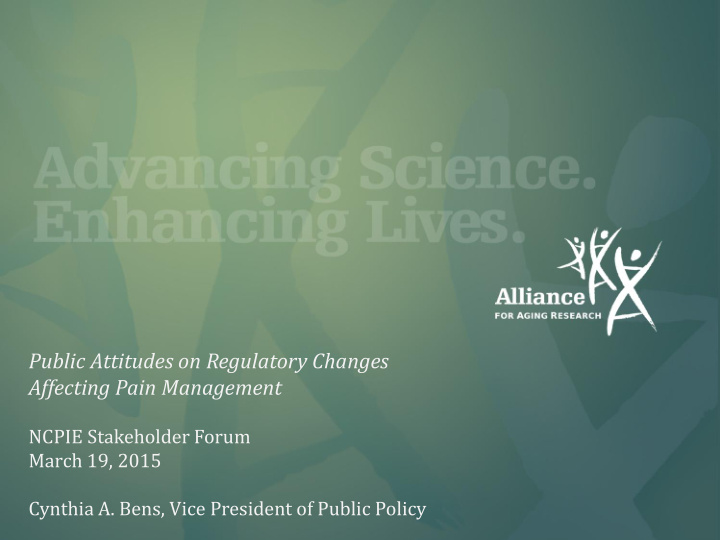



Public Attitudes on Regulatory Changes Affecting Pain Management NCPIE Stakeholder Forum March 19, 2015 Cynthia A. Bens, Vice President of Public Policy
About the Alliance WHO WE ARE The Alliance for Aging Research is the leading non-profit organization dedicated to accelerating the pace of scientific discoveries and their application in order to vastly improve the universal human experience of aging and health. www.agingresearch.org
Pain and Older Adults • Persistent pain affects 100 million Americans-- more than diabetes, heart disease, and cancer combined. • At least 1 in 3 Americans will experience severe, persistent pain during their lifetime. • Around half of adults 65 and older have been diagnosed with arthritis, a common cause of persistent pain. • Persistent pain is expensive, with an annual cost of at least $560 to $635 billion. • Older adults too often believe that pain is just a normal part of aging.
Alliance Pain Resources
Partners in Pain Awareness Pain Care Forum
Survey History • FDA concern over misuse and unintentional overdose of acetaminophen • Alliance and other stakeholders concerned over possible actions that would limit availability of OTC acetaminophen products • 2009 survey purpose – Better understand the role of acetaminophen in the lives of older adults; – Seek their reaction to the recommendations being considered by the FDA advisory committee; and – Determine what they might do if they no longer had access to higher strength doses of acetaminophen for pain management. • Support provided by McNeil Consumer Healthcare
OTC Pain Management Survey Survey Firm Clarus Research Group Date Conducted December 18 – 30, 2014 Sample Size N = 1,600 U.S. adults 18 – 59 years old (800), U.S. adults 60 years Sample Universe old and older (800) Methodology Live telephone interviewing, landline and cell calling Ronald A. Faucheux, Ph.D., President and Chief Analyst Analysis Andrew Rugg, Director and Analyst
OTC Pain Management Survey
OTC Pain Management Survey
Pain Reliever Use
Pain Reliever Use
OTC Pain Management Survey
OTC Pain Management Survey
OTC Pain Management Survey
Respondents who would “most likely” take more of lower dose College Income Pain Incidence Pain Severity Non- Pain College College $25K to $50K to $100K Every Pain Grad Grad >$25K $49K $99K or more Day Other Mild Bad It would be adequate to handle your pain 53% 58% 35% 56% 57% 64% 48% 59% 60% 39% level Don't have prescription insurance 6% 3% 5% - 4% 2% 6% 4% 4% 9% coverage Would have trouble getting to a doctor's 25% 16% 48% 19% 17% 17% 24% 19% 19% 28% office to get a prescription None of the above 15% 20% 10% 26% 21% 15% 19% 17% 16% 21%
Respondents who would “most likely” take more of lower dose Age Gender Gender/Age Race Male 18 Male Female Female 18 to 59 60+ 65+ Male Female to 59 60+ 18 to 59 60+ White Nonwhite It would be adequate to handle your pain 55% 58% 58% 59% 54% 54% 65% 55% 52% 56% 59% level Don't have prescription 5% 3% 2% 3% 5% 5% 1% 6% 5% 4% 6% insurance coverage Would have trouble getting to a doctor's 22% 18% 18% 20% 21% 23% 16% 21% 20% 21% 16% office to get a prescription None of the above 17% 19% 20% 17% 19% 17% 16% 17% 21% 18% 17%
Respondents who would “most likely” take more of lower dose
Respondents who would “most likely” change pain relievers College Income Pain Incidence Pain Severity Non- Pain College College $25K to $50K to $100K Every Pain Grad Grad >$25K $49K $99K or more Day Other Mild Bad Regular strength Tylenol or equivalent store brand would 25% 29% 23% 33% 26% 25% 31% 25% 25% 34% not be adequate to handle your pain Don't have prescription 8% 6% 9% 12% 6% 3% 4% 8% 8% 4% insurance coverage Would have trouble getting to a doctor's 28% 30% 24% 20% 35% 36% 23% 31% 29% 32% office to get a prescription None of the above 35% 33% 40% 31% 31% 35% 38% 32% 35% 29%
Respondents who would “most likely” change pain relievers Age Gender Gender/Age Race Male 18 Male Female Female 18 to 59 60+ 65+ Male Female to 59 60+ 18 to 59 60+ White Nonwhite Regular strength Tylenol or equivalent store brand would not 24% 30% 28% 27% 27% 28% 25% 22% 33% 26% 29% be adequate to handle your pain Don't have prescription 8% 6% 5% 8% 7% 7% 9% 9% 3% 6% 10% insurance coverage Would have trouble getting to a doctor's 34% 22% 21% 32% 27% 36% 25% 33% 19% 28% 32% office to get a prescription None of the above 30% 39% 43% 30% 37% 26% 36% 33% 41% 36% 28%
Respondents who would “most likely” change pain relievers
Key Points • Significant numbers of those over and under age 60 rely on OTC acetaminophen products to manage their pain • Those under age 60 and over age 60 prefer more education on safe use to further restriction by FDA • For various reasons, many respondents would chose to take more regular strength acetaminophen or switch to another OTC pain reliever as opposed to seeking a doctor’s prescription • Within the populations that said they would take more or switch, there are existing health conditions for which this would be a less appropriate alternative • It is our view that the FDA needs to consider this information before taking additional action to limit availability of acetaminophen doses over 500 mg
Thank you for your attention! Questions? Comments? Email: cbens@agingresearch.org Phone: 202-688-1230
Recommend
More recommend